University Research Proposal: Global Warming & Australian Farming
VerifiedAdded on 2022/11/01
|17
|5098
|456
Project
AI Summary
This research proposal examines the influence of global warming on Australia's key farming industries, specifically focusing on the challenges faced by farmers and the agricultural sector. The introduction highlights the significance of the topic, the background to the problem, and the justification for undertaking the research, emphasizing the industry's dependence on climatic conditions and the adverse effects of changing environmental conditions. The literature review synthesizes existing research, exploring the impacts of global warming on agricultural practices and the adaptation strategies employed by farmers. The proposal outlines the research question, aims, and ethical considerations, followed by a detailed description of the survey and interview methods proposed for data collection. The conclusion discusses the implications of the project, as well as its limitations. The research aims to identify the current and future challenges for farmers and propose new adaptation models. The research also includes appendices with research instruments and participant information sheets.
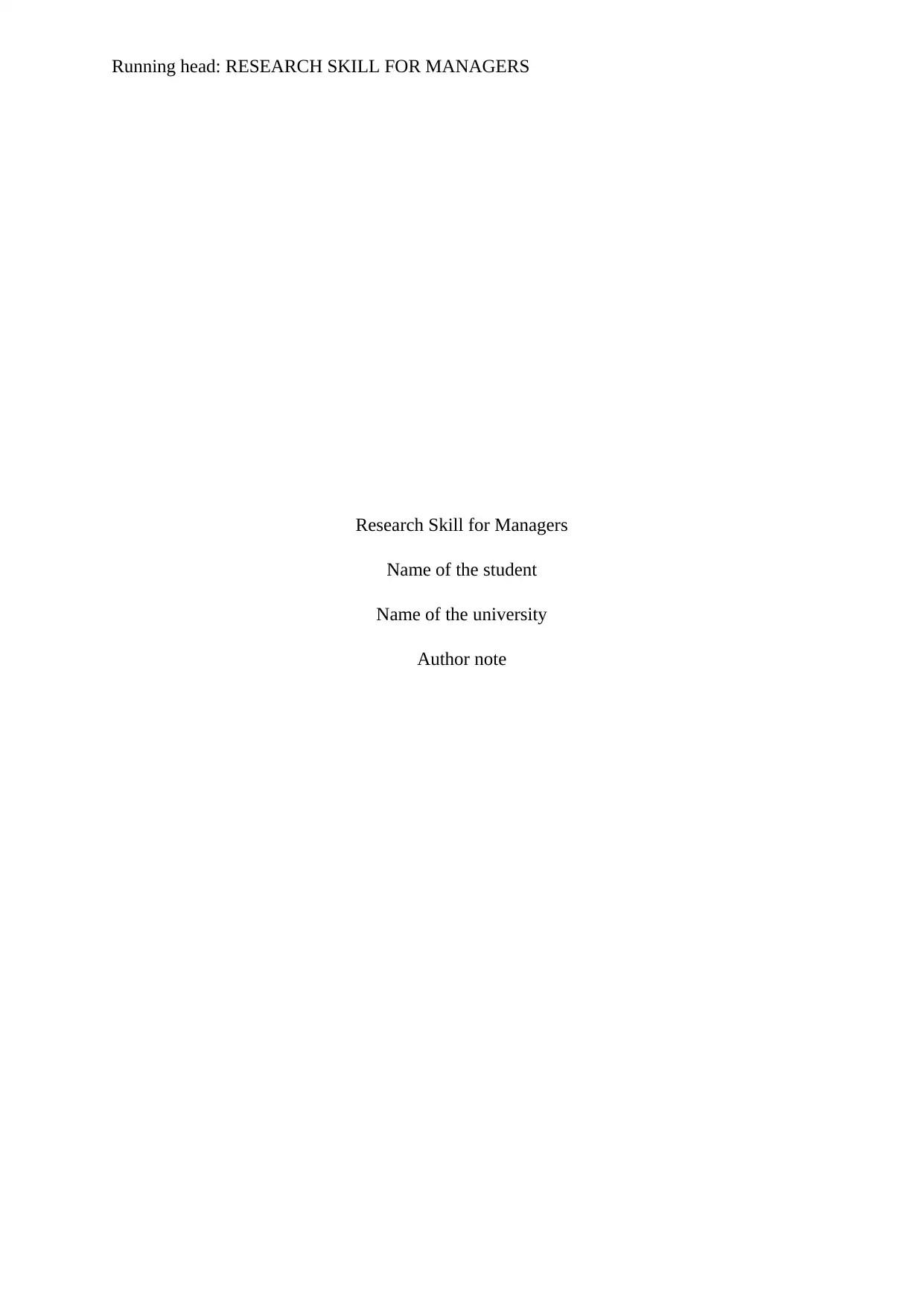
Running head: RESEARCH SKILL FOR MANAGERS
Research Skill for Managers
Name of the student
Name of the university
Author note
Research Skill for Managers
Name of the student
Name of the university
Author note
Paraphrase This Document
Need a fresh take? Get an instant paraphrase of this document with our AI Paraphraser
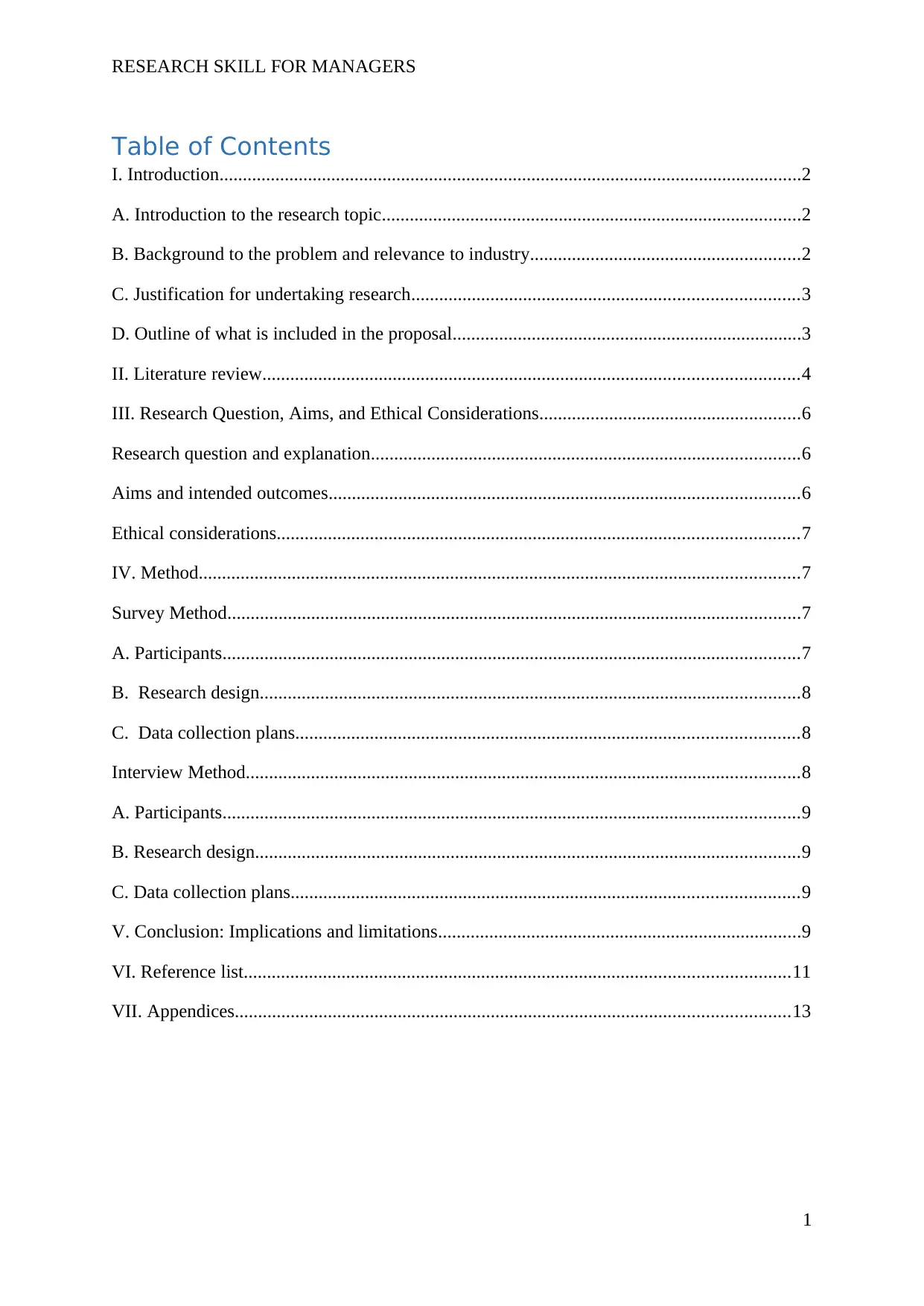
RESEARCH SKILL FOR MANAGERS
Table of Contents
I. Introduction.............................................................................................................................2
A. Introduction to the research topic..........................................................................................2
B. Background to the problem and relevance to industry..........................................................2
C. Justification for undertaking research...................................................................................3
D. Outline of what is included in the proposal...........................................................................3
II. Literature review...................................................................................................................4
III. Research Question, Aims, and Ethical Considerations........................................................6
Research question and explanation............................................................................................6
Aims and intended outcomes.....................................................................................................6
Ethical considerations................................................................................................................7
IV. Method.................................................................................................................................7
Survey Method...........................................................................................................................7
A. Participants............................................................................................................................7
B. Research design....................................................................................................................8
C. Data collection plans............................................................................................................8
Interview Method.......................................................................................................................8
A. Participants............................................................................................................................9
B. Research design.....................................................................................................................9
C. Data collection plans.............................................................................................................9
V. Conclusion: Implications and limitations..............................................................................9
VI. Reference list.....................................................................................................................11
VII. Appendices.......................................................................................................................13
1
Table of Contents
I. Introduction.............................................................................................................................2
A. Introduction to the research topic..........................................................................................2
B. Background to the problem and relevance to industry..........................................................2
C. Justification for undertaking research...................................................................................3
D. Outline of what is included in the proposal...........................................................................3
II. Literature review...................................................................................................................4
III. Research Question, Aims, and Ethical Considerations........................................................6
Research question and explanation............................................................................................6
Aims and intended outcomes.....................................................................................................6
Ethical considerations................................................................................................................7
IV. Method.................................................................................................................................7
Survey Method...........................................................................................................................7
A. Participants............................................................................................................................7
B. Research design....................................................................................................................8
C. Data collection plans............................................................................................................8
Interview Method.......................................................................................................................8
A. Participants............................................................................................................................9
B. Research design.....................................................................................................................9
C. Data collection plans.............................................................................................................9
V. Conclusion: Implications and limitations..............................................................................9
VI. Reference list.....................................................................................................................11
VII. Appendices.......................................................................................................................13
1
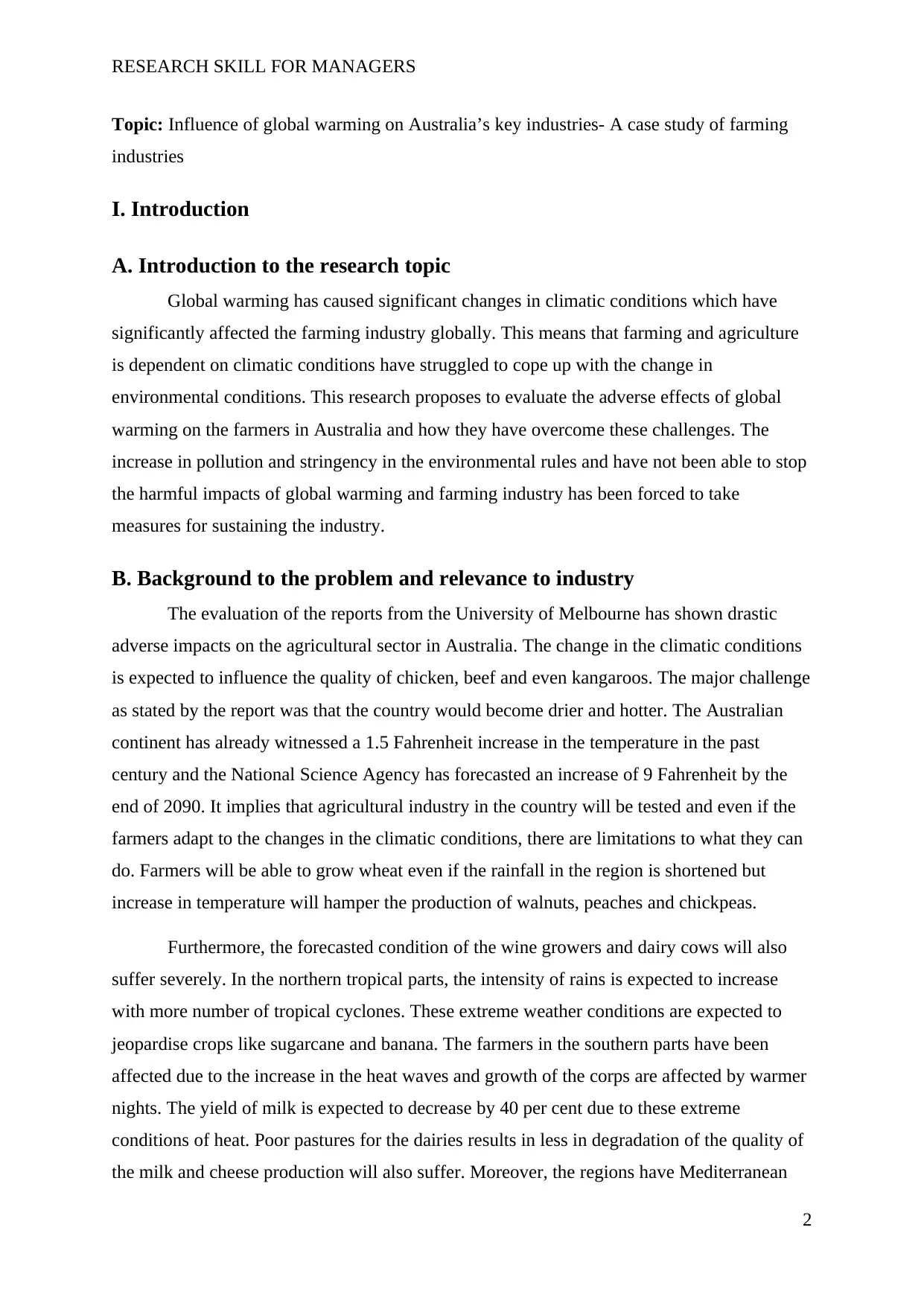
RESEARCH SKILL FOR MANAGERS
Topic: Influence of global warming on Australia’s key industries- A case study of farming
industries
I. Introduction
A. Introduction to the research topic
Global warming has caused significant changes in climatic conditions which have
significantly affected the farming industry globally. This means that farming and agriculture
is dependent on climatic conditions have struggled to cope up with the change in
environmental conditions. This research proposes to evaluate the adverse effects of global
warming on the farmers in Australia and how they have overcome these challenges. The
increase in pollution and stringency in the environmental rules and have not been able to stop
the harmful impacts of global warming and farming industry has been forced to take
measures for sustaining the industry.
B. Background to the problem and relevance to industry
The evaluation of the reports from the University of Melbourne has shown drastic
adverse impacts on the agricultural sector in Australia. The change in the climatic conditions
is expected to influence the quality of chicken, beef and even kangaroos. The major challenge
as stated by the report was that the country would become drier and hotter. The Australian
continent has already witnessed a 1.5 Fahrenheit increase in the temperature in the past
century and the National Science Agency has forecasted an increase of 9 Fahrenheit by the
end of 2090. It implies that agricultural industry in the country will be tested and even if the
farmers adapt to the changes in the climatic conditions, there are limitations to what they can
do. Farmers will be able to grow wheat even if the rainfall in the region is shortened but
increase in temperature will hamper the production of walnuts, peaches and chickpeas.
Furthermore, the forecasted condition of the wine growers and dairy cows will also
suffer severely. In the northern tropical parts, the intensity of rains is expected to increase
with more number of tropical cyclones. These extreme weather conditions are expected to
jeopardise crops like sugarcane and banana. The farmers in the southern parts have been
affected due to the increase in the heat waves and growth of the corps are affected by warmer
nights. The yield of milk is expected to decrease by 40 per cent due to these extreme
conditions of heat. Poor pastures for the dairies results in less in degradation of the quality of
the milk and cheese production will also suffer. Moreover, the regions have Mediterranean
2
Topic: Influence of global warming on Australia’s key industries- A case study of farming
industries
I. Introduction
A. Introduction to the research topic
Global warming has caused significant changes in climatic conditions which have
significantly affected the farming industry globally. This means that farming and agriculture
is dependent on climatic conditions have struggled to cope up with the change in
environmental conditions. This research proposes to evaluate the adverse effects of global
warming on the farmers in Australia and how they have overcome these challenges. The
increase in pollution and stringency in the environmental rules and have not been able to stop
the harmful impacts of global warming and farming industry has been forced to take
measures for sustaining the industry.
B. Background to the problem and relevance to industry
The evaluation of the reports from the University of Melbourne has shown drastic
adverse impacts on the agricultural sector in Australia. The change in the climatic conditions
is expected to influence the quality of chicken, beef and even kangaroos. The major challenge
as stated by the report was that the country would become drier and hotter. The Australian
continent has already witnessed a 1.5 Fahrenheit increase in the temperature in the past
century and the National Science Agency has forecasted an increase of 9 Fahrenheit by the
end of 2090. It implies that agricultural industry in the country will be tested and even if the
farmers adapt to the changes in the climatic conditions, there are limitations to what they can
do. Farmers will be able to grow wheat even if the rainfall in the region is shortened but
increase in temperature will hamper the production of walnuts, peaches and chickpeas.
Furthermore, the forecasted condition of the wine growers and dairy cows will also
suffer severely. In the northern tropical parts, the intensity of rains is expected to increase
with more number of tropical cyclones. These extreme weather conditions are expected to
jeopardise crops like sugarcane and banana. The farmers in the southern parts have been
affected due to the increase in the heat waves and growth of the corps are affected by warmer
nights. The yield of milk is expected to decrease by 40 per cent due to these extreme
conditions of heat. Poor pastures for the dairies results in less in degradation of the quality of
the milk and cheese production will also suffer. Moreover, the regions have Mediterranean
2
⊘ This is a preview!⊘
Do you want full access?
Subscribe today to unlock all pages.

Trusted by 1+ million students worldwide
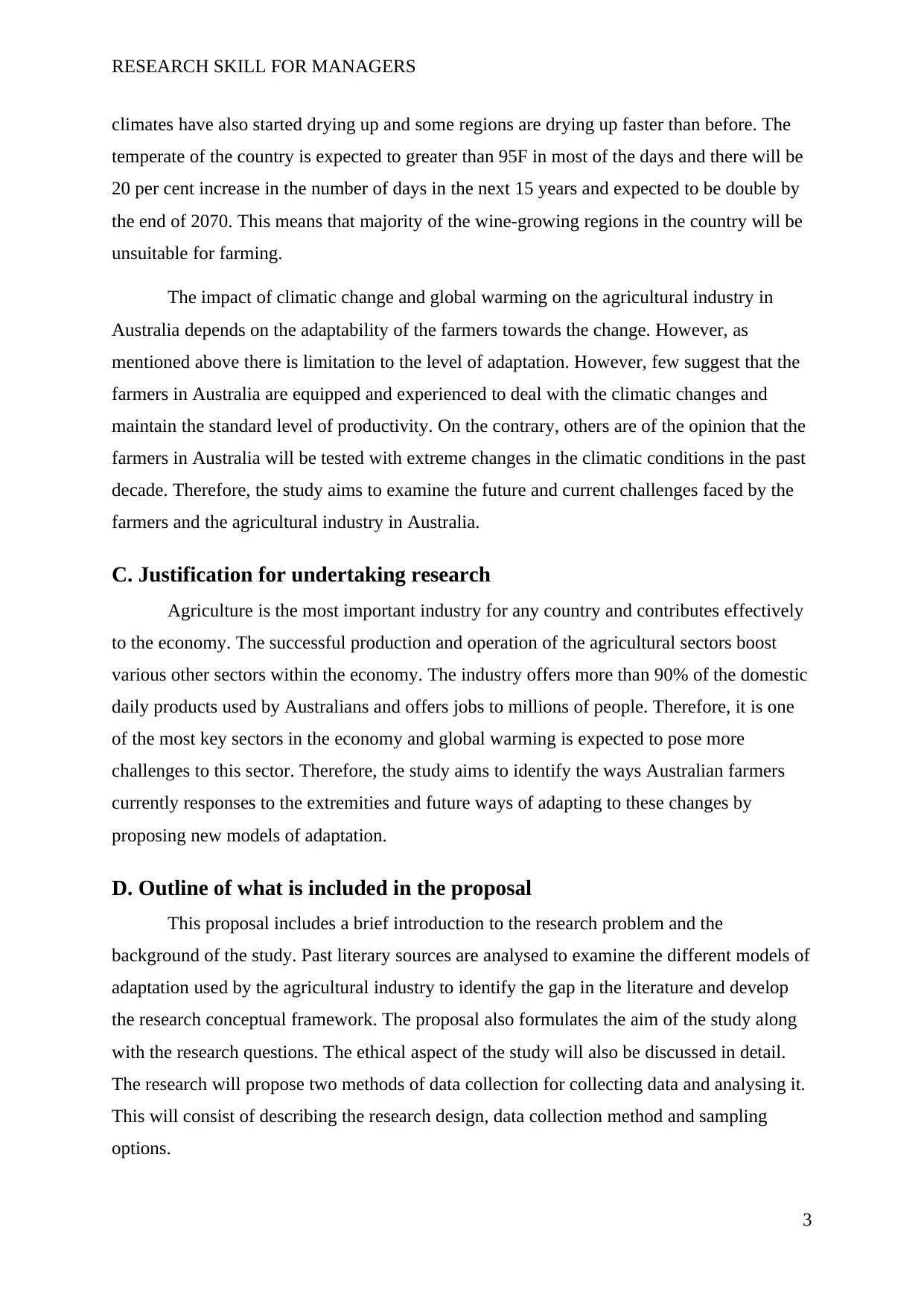
RESEARCH SKILL FOR MANAGERS
climates have also started drying up and some regions are drying up faster than before. The
temperate of the country is expected to greater than 95F in most of the days and there will be
20 per cent increase in the number of days in the next 15 years and expected to be double by
the end of 2070. This means that majority of the wine-growing regions in the country will be
unsuitable for farming.
The impact of climatic change and global warming on the agricultural industry in
Australia depends on the adaptability of the farmers towards the change. However, as
mentioned above there is limitation to the level of adaptation. However, few suggest that the
farmers in Australia are equipped and experienced to deal with the climatic changes and
maintain the standard level of productivity. On the contrary, others are of the opinion that the
farmers in Australia will be tested with extreme changes in the climatic conditions in the past
decade. Therefore, the study aims to examine the future and current challenges faced by the
farmers and the agricultural industry in Australia.
C. Justification for undertaking research
Agriculture is the most important industry for any country and contributes effectively
to the economy. The successful production and operation of the agricultural sectors boost
various other sectors within the economy. The industry offers more than 90% of the domestic
daily products used by Australians and offers jobs to millions of people. Therefore, it is one
of the most key sectors in the economy and global warming is expected to pose more
challenges to this sector. Therefore, the study aims to identify the ways Australian farmers
currently responses to the extremities and future ways of adapting to these changes by
proposing new models of adaptation.
D. Outline of what is included in the proposal
This proposal includes a brief introduction to the research problem and the
background of the study. Past literary sources are analysed to examine the different models of
adaptation used by the agricultural industry to identify the gap in the literature and develop
the research conceptual framework. The proposal also formulates the aim of the study along
with the research questions. The ethical aspect of the study will also be discussed in detail.
The research will propose two methods of data collection for collecting data and analysing it.
This will consist of describing the research design, data collection method and sampling
options.
3
climates have also started drying up and some regions are drying up faster than before. The
temperate of the country is expected to greater than 95F in most of the days and there will be
20 per cent increase in the number of days in the next 15 years and expected to be double by
the end of 2070. This means that majority of the wine-growing regions in the country will be
unsuitable for farming.
The impact of climatic change and global warming on the agricultural industry in
Australia depends on the adaptability of the farmers towards the change. However, as
mentioned above there is limitation to the level of adaptation. However, few suggest that the
farmers in Australia are equipped and experienced to deal with the climatic changes and
maintain the standard level of productivity. On the contrary, others are of the opinion that the
farmers in Australia will be tested with extreme changes in the climatic conditions in the past
decade. Therefore, the study aims to examine the future and current challenges faced by the
farmers and the agricultural industry in Australia.
C. Justification for undertaking research
Agriculture is the most important industry for any country and contributes effectively
to the economy. The successful production and operation of the agricultural sectors boost
various other sectors within the economy. The industry offers more than 90% of the domestic
daily products used by Australians and offers jobs to millions of people. Therefore, it is one
of the most key sectors in the economy and global warming is expected to pose more
challenges to this sector. Therefore, the study aims to identify the ways Australian farmers
currently responses to the extremities and future ways of adapting to these changes by
proposing new models of adaptation.
D. Outline of what is included in the proposal
This proposal includes a brief introduction to the research problem and the
background of the study. Past literary sources are analysed to examine the different models of
adaptation used by the agricultural industry to identify the gap in the literature and develop
the research conceptual framework. The proposal also formulates the aim of the study along
with the research questions. The ethical aspect of the study will also be discussed in detail.
The research will propose two methods of data collection for collecting data and analysing it.
This will consist of describing the research design, data collection method and sampling
options.
3
Paraphrase This Document
Need a fresh take? Get an instant paraphrase of this document with our AI Paraphraser
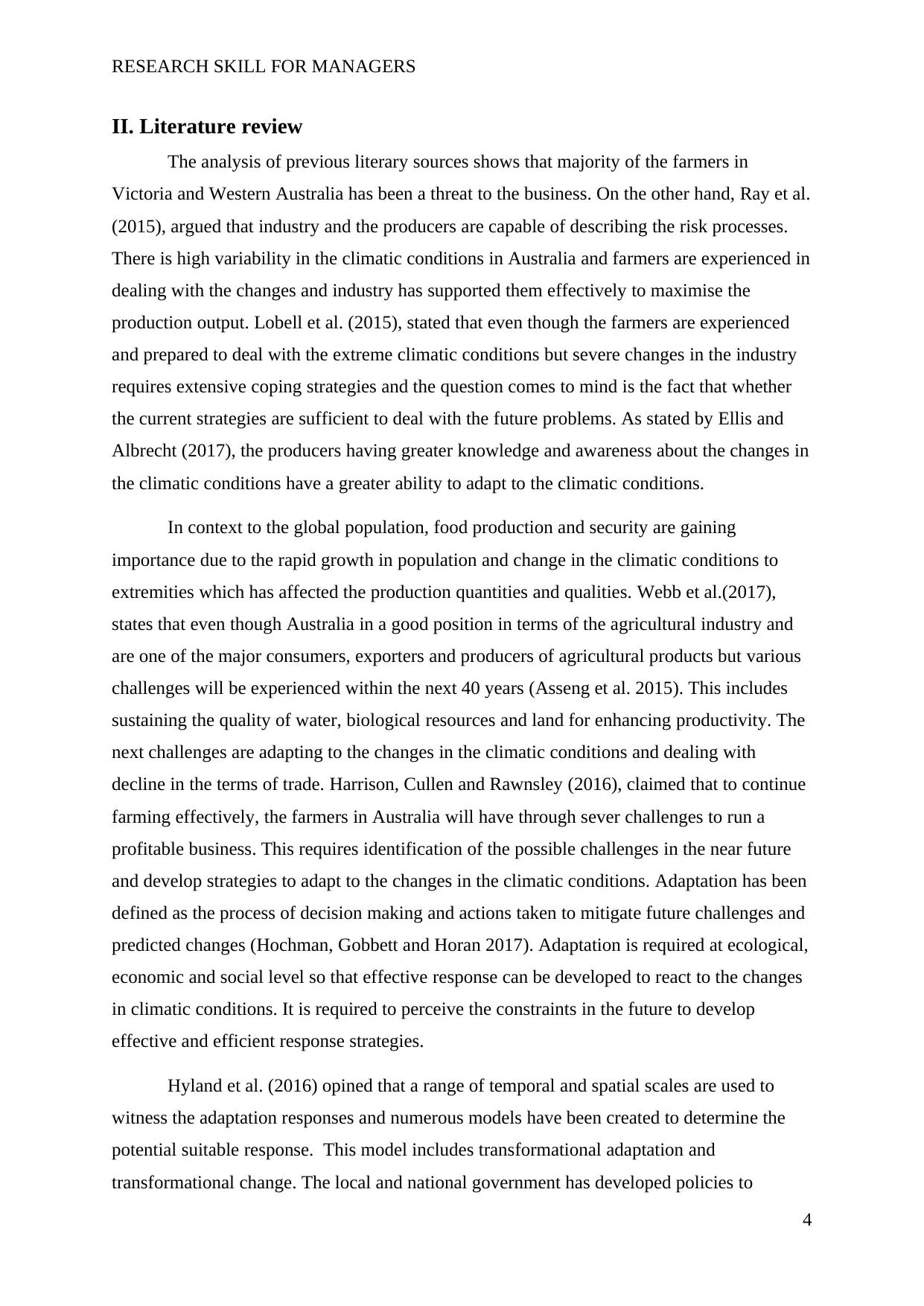
RESEARCH SKILL FOR MANAGERS
II. Literature review
The analysis of previous literary sources shows that majority of the farmers in
Victoria and Western Australia has been a threat to the business. On the other hand, Ray et al.
(2015), argued that industry and the producers are capable of describing the risk processes.
There is high variability in the climatic conditions in Australia and farmers are experienced in
dealing with the changes and industry has supported them effectively to maximise the
production output. Lobell et al. (2015), stated that even though the farmers are experienced
and prepared to deal with the extreme climatic conditions but severe changes in the industry
requires extensive coping strategies and the question comes to mind is the fact that whether
the current strategies are sufficient to deal with the future problems. As stated by Ellis and
Albrecht (2017), the producers having greater knowledge and awareness about the changes in
the climatic conditions have a greater ability to adapt to the climatic conditions.
In context to the global population, food production and security are gaining
importance due to the rapid growth in population and change in the climatic conditions to
extremities which has affected the production quantities and qualities. Webb et al.(2017),
states that even though Australia in a good position in terms of the agricultural industry and
are one of the major consumers, exporters and producers of agricultural products but various
challenges will be experienced within the next 40 years (Asseng et al. 2015). This includes
sustaining the quality of water, biological resources and land for enhancing productivity. The
next challenges are adapting to the changes in the climatic conditions and dealing with
decline in the terms of trade. Harrison, Cullen and Rawnsley (2016), claimed that to continue
farming effectively, the farmers in Australia will have through sever challenges to run a
profitable business. This requires identification of the possible challenges in the near future
and develop strategies to adapt to the changes in the climatic conditions. Adaptation has been
defined as the process of decision making and actions taken to mitigate future challenges and
predicted changes (Hochman, Gobbett and Horan 2017). Adaptation is required at ecological,
economic and social level so that effective response can be developed to react to the changes
in climatic conditions. It is required to perceive the constraints in the future to develop
effective and efficient response strategies.
Hyland et al. (2016) opined that a range of temporal and spatial scales are used to
witness the adaptation responses and numerous models have been created to determine the
potential suitable response. This model includes transformational adaptation and
transformational change. The local and national government has developed policies to
4
II. Literature review
The analysis of previous literary sources shows that majority of the farmers in
Victoria and Western Australia has been a threat to the business. On the other hand, Ray et al.
(2015), argued that industry and the producers are capable of describing the risk processes.
There is high variability in the climatic conditions in Australia and farmers are experienced in
dealing with the changes and industry has supported them effectively to maximise the
production output. Lobell et al. (2015), stated that even though the farmers are experienced
and prepared to deal with the extreme climatic conditions but severe changes in the industry
requires extensive coping strategies and the question comes to mind is the fact that whether
the current strategies are sufficient to deal with the future problems. As stated by Ellis and
Albrecht (2017), the producers having greater knowledge and awareness about the changes in
the climatic conditions have a greater ability to adapt to the climatic conditions.
In context to the global population, food production and security are gaining
importance due to the rapid growth in population and change in the climatic conditions to
extremities which has affected the production quantities and qualities. Webb et al.(2017),
states that even though Australia in a good position in terms of the agricultural industry and
are one of the major consumers, exporters and producers of agricultural products but various
challenges will be experienced within the next 40 years (Asseng et al. 2015). This includes
sustaining the quality of water, biological resources and land for enhancing productivity. The
next challenges are adapting to the changes in the climatic conditions and dealing with
decline in the terms of trade. Harrison, Cullen and Rawnsley (2016), claimed that to continue
farming effectively, the farmers in Australia will have through sever challenges to run a
profitable business. This requires identification of the possible challenges in the near future
and develop strategies to adapt to the changes in the climatic conditions. Adaptation has been
defined as the process of decision making and actions taken to mitigate future challenges and
predicted changes (Hochman, Gobbett and Horan 2017). Adaptation is required at ecological,
economic and social level so that effective response can be developed to react to the changes
in climatic conditions. It is required to perceive the constraints in the future to develop
effective and efficient response strategies.
Hyland et al. (2016) opined that a range of temporal and spatial scales are used to
witness the adaptation responses and numerous models have been created to determine the
potential suitable response. This model includes transformational adaptation and
transformational change. The local and national government has developed policies to
4
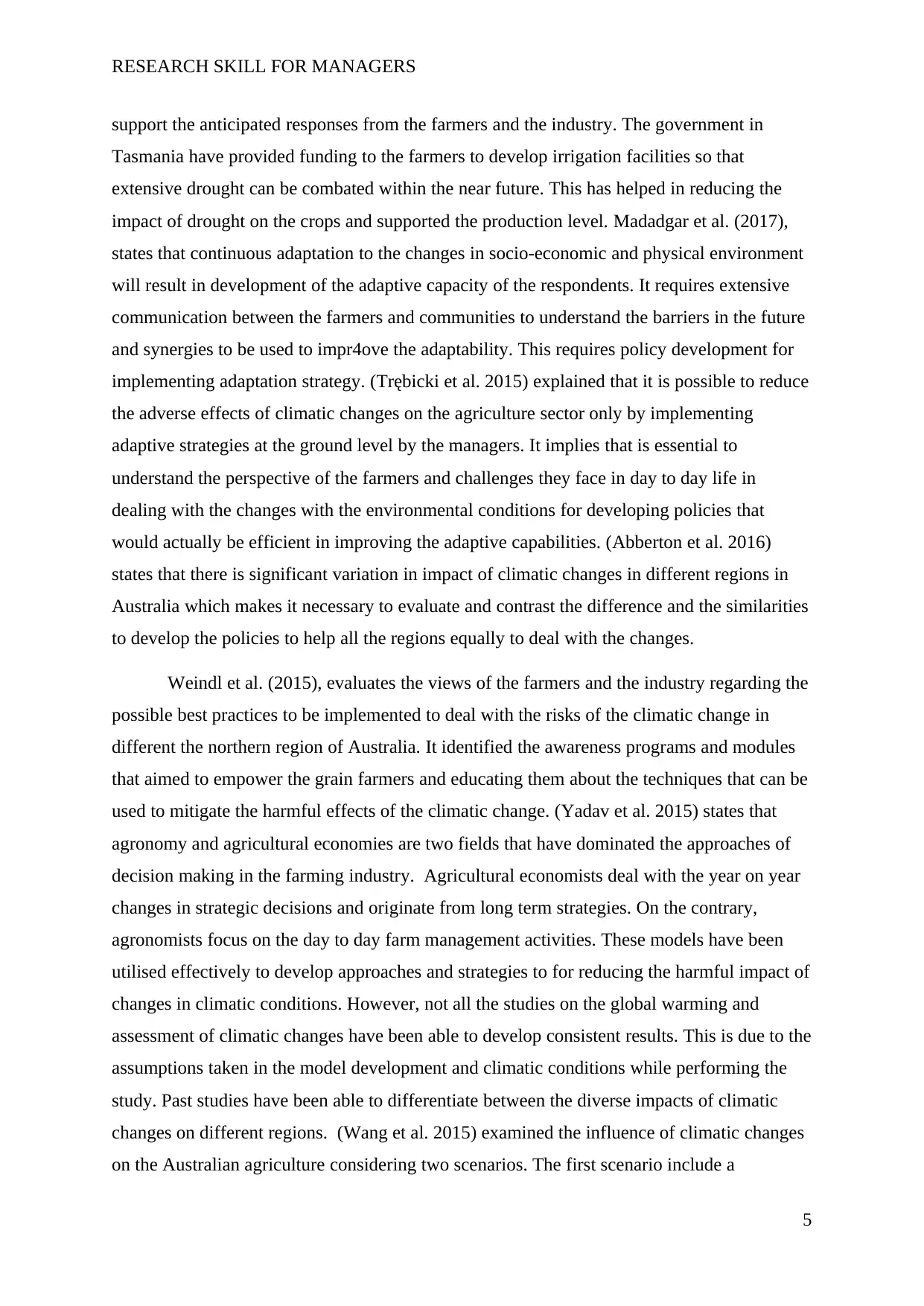
RESEARCH SKILL FOR MANAGERS
support the anticipated responses from the farmers and the industry. The government in
Tasmania have provided funding to the farmers to develop irrigation facilities so that
extensive drought can be combated within the near future. This has helped in reducing the
impact of drought on the crops and supported the production level. Madadgar et al. (2017),
states that continuous adaptation to the changes in socio-economic and physical environment
will result in development of the adaptive capacity of the respondents. It requires extensive
communication between the farmers and communities to understand the barriers in the future
and synergies to be used to impr4ove the adaptability. This requires policy development for
implementing adaptation strategy. (Trębicki et al. 2015) explained that it is possible to reduce
the adverse effects of climatic changes on the agriculture sector only by implementing
adaptive strategies at the ground level by the managers. It implies that is essential to
understand the perspective of the farmers and challenges they face in day to day life in
dealing with the changes with the environmental conditions for developing policies that
would actually be efficient in improving the adaptive capabilities. (Abberton et al. 2016)
states that there is significant variation in impact of climatic changes in different regions in
Australia which makes it necessary to evaluate and contrast the difference and the similarities
to develop the policies to help all the regions equally to deal with the changes.
Weindl et al. (2015), evaluates the views of the farmers and the industry regarding the
possible best practices to be implemented to deal with the risks of the climatic change in
different the northern region of Australia. It identified the awareness programs and modules
that aimed to empower the grain farmers and educating them about the techniques that can be
used to mitigate the harmful effects of the climatic change. (Yadav et al. 2015) states that
agronomy and agricultural economies are two fields that have dominated the approaches of
decision making in the farming industry. Agricultural economists deal with the year on year
changes in strategic decisions and originate from long term strategies. On the contrary,
agronomists focus on the day to day farm management activities. These models have been
utilised effectively to develop approaches and strategies to for reducing the harmful impact of
changes in climatic conditions. However, not all the studies on the global warming and
assessment of climatic changes have been able to develop consistent results. This is due to the
assumptions taken in the model development and climatic conditions while performing the
study. Past studies have been able to differentiate between the diverse impacts of climatic
changes on different regions. (Wang et al. 2015) examined the influence of climatic changes
on the Australian agriculture considering two scenarios. The first scenario include a
5
support the anticipated responses from the farmers and the industry. The government in
Tasmania have provided funding to the farmers to develop irrigation facilities so that
extensive drought can be combated within the near future. This has helped in reducing the
impact of drought on the crops and supported the production level. Madadgar et al. (2017),
states that continuous adaptation to the changes in socio-economic and physical environment
will result in development of the adaptive capacity of the respondents. It requires extensive
communication between the farmers and communities to understand the barriers in the future
and synergies to be used to impr4ove the adaptability. This requires policy development for
implementing adaptation strategy. (Trębicki et al. 2015) explained that it is possible to reduce
the adverse effects of climatic changes on the agriculture sector only by implementing
adaptive strategies at the ground level by the managers. It implies that is essential to
understand the perspective of the farmers and challenges they face in day to day life in
dealing with the changes with the environmental conditions for developing policies that
would actually be efficient in improving the adaptive capabilities. (Abberton et al. 2016)
states that there is significant variation in impact of climatic changes in different regions in
Australia which makes it necessary to evaluate and contrast the difference and the similarities
to develop the policies to help all the regions equally to deal with the changes.
Weindl et al. (2015), evaluates the views of the farmers and the industry regarding the
possible best practices to be implemented to deal with the risks of the climatic change in
different the northern region of Australia. It identified the awareness programs and modules
that aimed to empower the grain farmers and educating them about the techniques that can be
used to mitigate the harmful effects of the climatic change. (Yadav et al. 2015) states that
agronomy and agricultural economies are two fields that have dominated the approaches of
decision making in the farming industry. Agricultural economists deal with the year on year
changes in strategic decisions and originate from long term strategies. On the contrary,
agronomists focus on the day to day farm management activities. These models have been
utilised effectively to develop approaches and strategies to for reducing the harmful impact of
changes in climatic conditions. However, not all the studies on the global warming and
assessment of climatic changes have been able to develop consistent results. This is due to the
assumptions taken in the model development and climatic conditions while performing the
study. Past studies have been able to differentiate between the diverse impacts of climatic
changes on different regions. (Wang et al. 2015) examined the influence of climatic changes
on the Australian agriculture considering two scenarios. The first scenario include a
5
⊘ This is a preview!⊘
Do you want full access?
Subscribe today to unlock all pages.

Trusted by 1+ million students worldwide
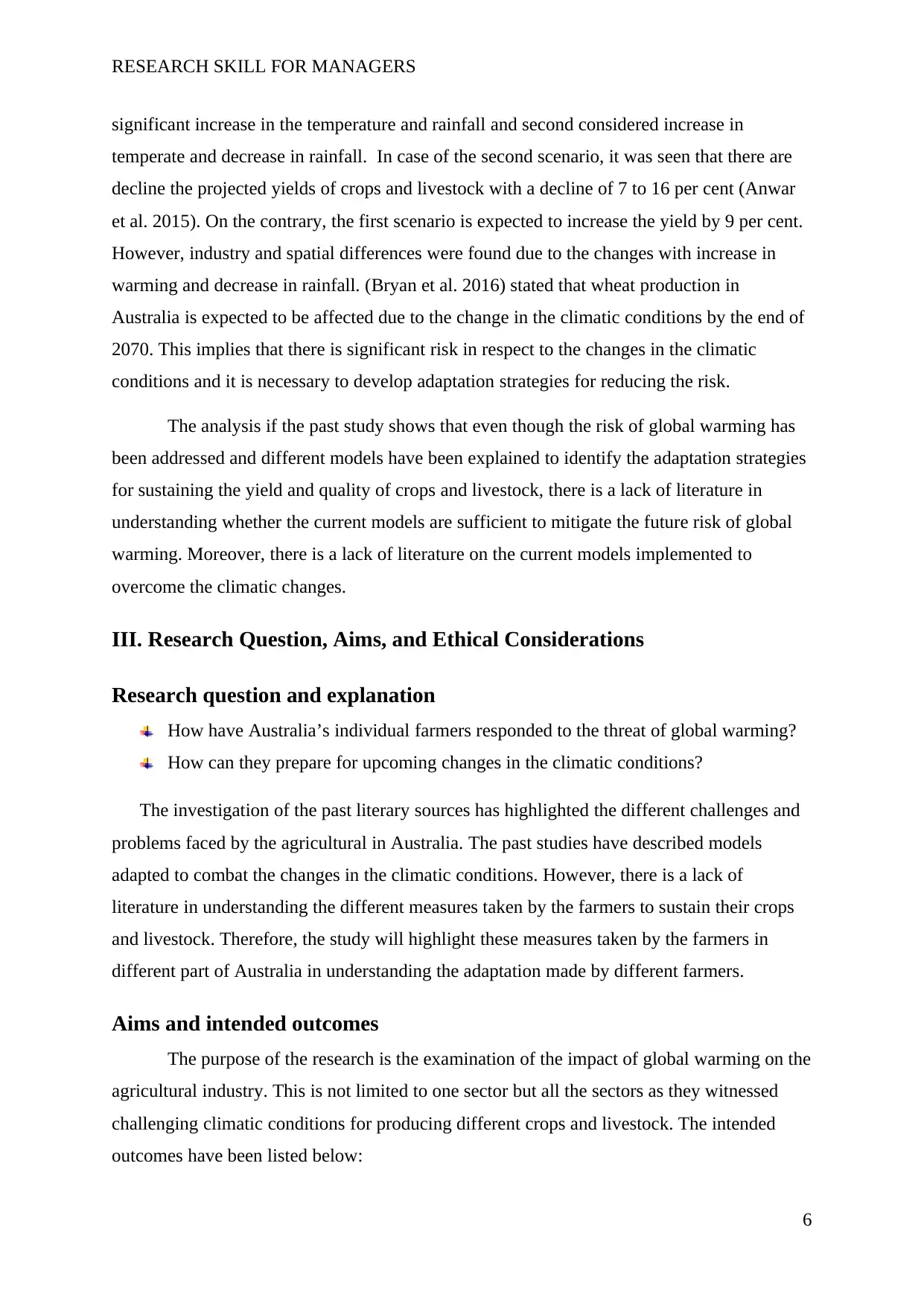
RESEARCH SKILL FOR MANAGERS
significant increase in the temperature and rainfall and second considered increase in
temperate and decrease in rainfall. In case of the second scenario, it was seen that there are
decline the projected yields of crops and livestock with a decline of 7 to 16 per cent (Anwar
et al. 2015). On the contrary, the first scenario is expected to increase the yield by 9 per cent.
However, industry and spatial differences were found due to the changes with increase in
warming and decrease in rainfall. (Bryan et al. 2016) stated that wheat production in
Australia is expected to be affected due to the change in the climatic conditions by the end of
2070. This implies that there is significant risk in respect to the changes in the climatic
conditions and it is necessary to develop adaptation strategies for reducing the risk.
The analysis if the past study shows that even though the risk of global warming has
been addressed and different models have been explained to identify the adaptation strategies
for sustaining the yield and quality of crops and livestock, there is a lack of literature in
understanding whether the current models are sufficient to mitigate the future risk of global
warming. Moreover, there is a lack of literature on the current models implemented to
overcome the climatic changes.
III. Research Question, Aims, and Ethical Considerations
Research question and explanation
How have Australia’s individual farmers responded to the threat of global warming?
How can they prepare for upcoming changes in the climatic conditions?
The investigation of the past literary sources has highlighted the different challenges and
problems faced by the agricultural in Australia. The past studies have described models
adapted to combat the changes in the climatic conditions. However, there is a lack of
literature in understanding the different measures taken by the farmers to sustain their crops
and livestock. Therefore, the study will highlight these measures taken by the farmers in
different part of Australia in understanding the adaptation made by different farmers.
Aims and intended outcomes
The purpose of the research is the examination of the impact of global warming on the
agricultural industry. This is not limited to one sector but all the sectors as they witnessed
challenging climatic conditions for producing different crops and livestock. The intended
outcomes have been listed below:
6
significant increase in the temperature and rainfall and second considered increase in
temperate and decrease in rainfall. In case of the second scenario, it was seen that there are
decline the projected yields of crops and livestock with a decline of 7 to 16 per cent (Anwar
et al. 2015). On the contrary, the first scenario is expected to increase the yield by 9 per cent.
However, industry and spatial differences were found due to the changes with increase in
warming and decrease in rainfall. (Bryan et al. 2016) stated that wheat production in
Australia is expected to be affected due to the change in the climatic conditions by the end of
2070. This implies that there is significant risk in respect to the changes in the climatic
conditions and it is necessary to develop adaptation strategies for reducing the risk.
The analysis if the past study shows that even though the risk of global warming has
been addressed and different models have been explained to identify the adaptation strategies
for sustaining the yield and quality of crops and livestock, there is a lack of literature in
understanding whether the current models are sufficient to mitigate the future risk of global
warming. Moreover, there is a lack of literature on the current models implemented to
overcome the climatic changes.
III. Research Question, Aims, and Ethical Considerations
Research question and explanation
How have Australia’s individual farmers responded to the threat of global warming?
How can they prepare for upcoming changes in the climatic conditions?
The investigation of the past literary sources has highlighted the different challenges and
problems faced by the agricultural in Australia. The past studies have described models
adapted to combat the changes in the climatic conditions. However, there is a lack of
literature in understanding the different measures taken by the farmers to sustain their crops
and livestock. Therefore, the study will highlight these measures taken by the farmers in
different part of Australia in understanding the adaptation made by different farmers.
Aims and intended outcomes
The purpose of the research is the examination of the impact of global warming on the
agricultural industry. This is not limited to one sector but all the sectors as they witnessed
challenging climatic conditions for producing different crops and livestock. The intended
outcomes have been listed below:
6
Paraphrase This Document
Need a fresh take? Get an instant paraphrase of this document with our AI Paraphraser
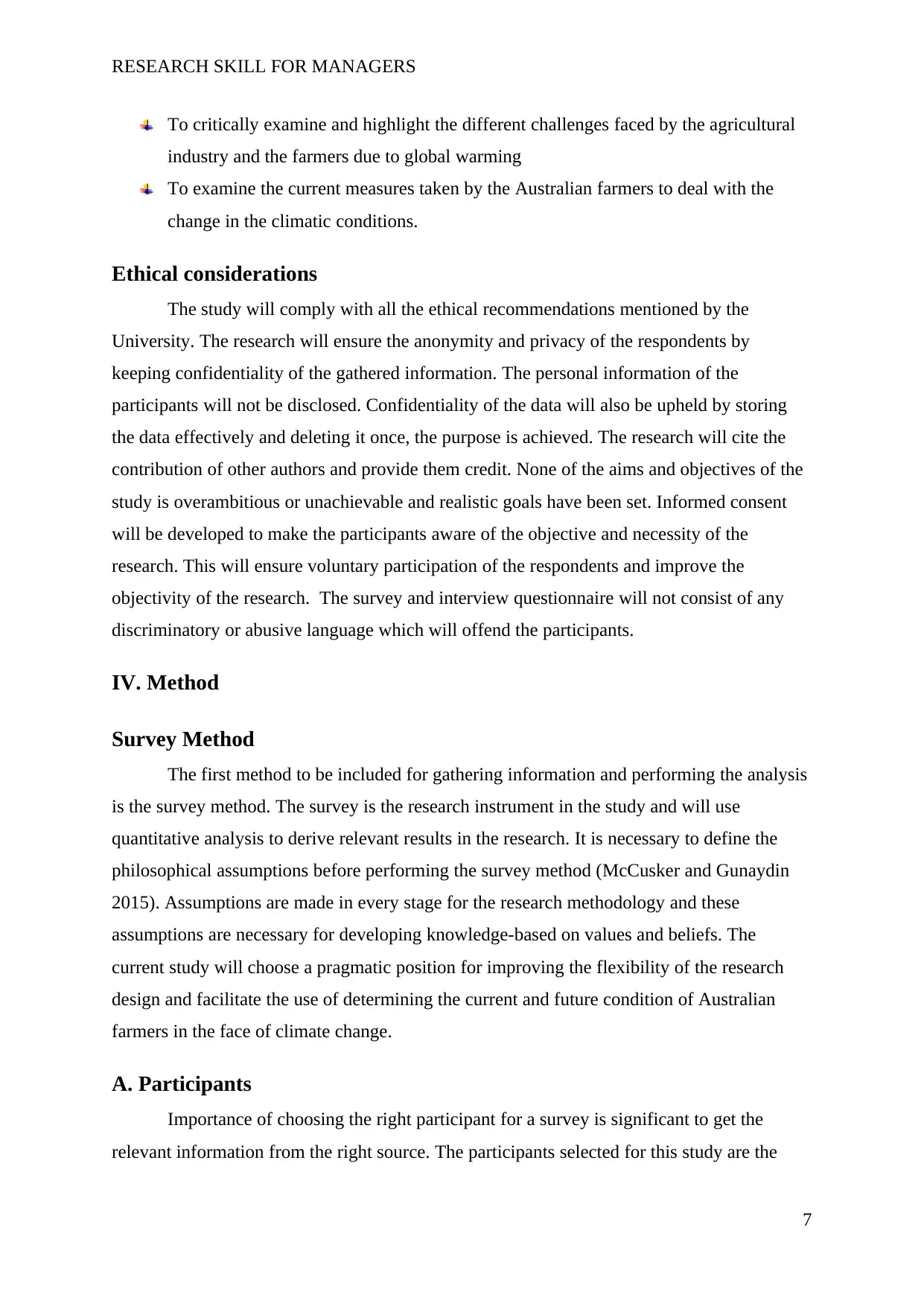
RESEARCH SKILL FOR MANAGERS
To critically examine and highlight the different challenges faced by the agricultural
industry and the farmers due to global warming
To examine the current measures taken by the Australian farmers to deal with the
change in the climatic conditions.
Ethical considerations
The study will comply with all the ethical recommendations mentioned by the
University. The research will ensure the anonymity and privacy of the respondents by
keeping confidentiality of the gathered information. The personal information of the
participants will not be disclosed. Confidentiality of the data will also be upheld by storing
the data effectively and deleting it once, the purpose is achieved. The research will cite the
contribution of other authors and provide them credit. None of the aims and objectives of the
study is overambitious or unachievable and realistic goals have been set. Informed consent
will be developed to make the participants aware of the objective and necessity of the
research. This will ensure voluntary participation of the respondents and improve the
objectivity of the research. The survey and interview questionnaire will not consist of any
discriminatory or abusive language which will offend the participants.
IV. Method
Survey Method
The first method to be included for gathering information and performing the analysis
is the survey method. The survey is the research instrument in the study and will use
quantitative analysis to derive relevant results in the research. It is necessary to define the
philosophical assumptions before performing the survey method (McCusker and Gunaydin
2015). Assumptions are made in every stage for the research methodology and these
assumptions are necessary for developing knowledge-based on values and beliefs. The
current study will choose a pragmatic position for improving the flexibility of the research
design and facilitate the use of determining the current and future condition of Australian
farmers in the face of climate change.
A. Participants
Importance of choosing the right participant for a survey is significant to get the
relevant information from the right source. The participants selected for this study are the
7
To critically examine and highlight the different challenges faced by the agricultural
industry and the farmers due to global warming
To examine the current measures taken by the Australian farmers to deal with the
change in the climatic conditions.
Ethical considerations
The study will comply with all the ethical recommendations mentioned by the
University. The research will ensure the anonymity and privacy of the respondents by
keeping confidentiality of the gathered information. The personal information of the
participants will not be disclosed. Confidentiality of the data will also be upheld by storing
the data effectively and deleting it once, the purpose is achieved. The research will cite the
contribution of other authors and provide them credit. None of the aims and objectives of the
study is overambitious or unachievable and realistic goals have been set. Informed consent
will be developed to make the participants aware of the objective and necessity of the
research. This will ensure voluntary participation of the respondents and improve the
objectivity of the research. The survey and interview questionnaire will not consist of any
discriminatory or abusive language which will offend the participants.
IV. Method
Survey Method
The first method to be included for gathering information and performing the analysis
is the survey method. The survey is the research instrument in the study and will use
quantitative analysis to derive relevant results in the research. It is necessary to define the
philosophical assumptions before performing the survey method (McCusker and Gunaydin
2015). Assumptions are made in every stage for the research methodology and these
assumptions are necessary for developing knowledge-based on values and beliefs. The
current study will choose a pragmatic position for improving the flexibility of the research
design and facilitate the use of determining the current and future condition of Australian
farmers in the face of climate change.
A. Participants
Importance of choosing the right participant for a survey is significant to get the
relevant information from the right source. The participants selected for this study are the
7
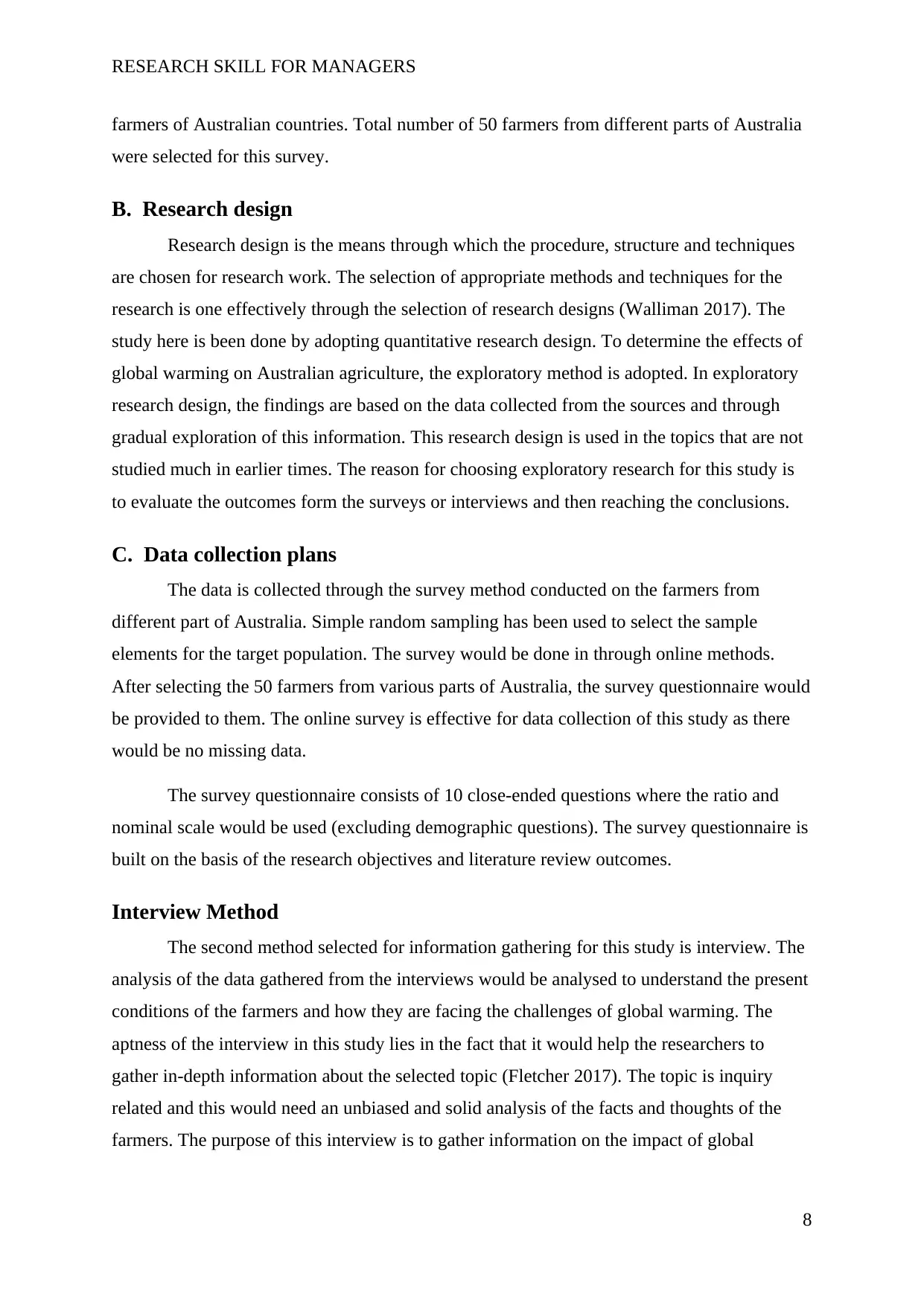
RESEARCH SKILL FOR MANAGERS
farmers of Australian countries. Total number of 50 farmers from different parts of Australia
were selected for this survey.
B. Research design
Research design is the means through which the procedure, structure and techniques
are chosen for research work. The selection of appropriate methods and techniques for the
research is one effectively through the selection of research designs (Walliman 2017). The
study here is been done by adopting quantitative research design. To determine the effects of
global warming on Australian agriculture, the exploratory method is adopted. In exploratory
research design, the findings are based on the data collected from the sources and through
gradual exploration of this information. This research design is used in the topics that are not
studied much in earlier times. The reason for choosing exploratory research for this study is
to evaluate the outcomes form the surveys or interviews and then reaching the conclusions.
C. Data collection plans
The data is collected through the survey method conducted on the farmers from
different part of Australia. Simple random sampling has been used to select the sample
elements for the target population. The survey would be done in through online methods.
After selecting the 50 farmers from various parts of Australia, the survey questionnaire would
be provided to them. The online survey is effective for data collection of this study as there
would be no missing data.
The survey questionnaire consists of 10 close-ended questions where the ratio and
nominal scale would be used (excluding demographic questions). The survey questionnaire is
built on the basis of the research objectives and literature review outcomes.
Interview Method
The second method selected for information gathering for this study is interview. The
analysis of the data gathered from the interviews would be analysed to understand the present
conditions of the farmers and how they are facing the challenges of global warming. The
aptness of the interview in this study lies in the fact that it would help the researchers to
gather in-depth information about the selected topic (Fletcher 2017). The topic is inquiry
related and this would need an unbiased and solid analysis of the facts and thoughts of the
farmers. The purpose of this interview is to gather information on the impact of global
8
farmers of Australian countries. Total number of 50 farmers from different parts of Australia
were selected for this survey.
B. Research design
Research design is the means through which the procedure, structure and techniques
are chosen for research work. The selection of appropriate methods and techniques for the
research is one effectively through the selection of research designs (Walliman 2017). The
study here is been done by adopting quantitative research design. To determine the effects of
global warming on Australian agriculture, the exploratory method is adopted. In exploratory
research design, the findings are based on the data collected from the sources and through
gradual exploration of this information. This research design is used in the topics that are not
studied much in earlier times. The reason for choosing exploratory research for this study is
to evaluate the outcomes form the surveys or interviews and then reaching the conclusions.
C. Data collection plans
The data is collected through the survey method conducted on the farmers from
different part of Australia. Simple random sampling has been used to select the sample
elements for the target population. The survey would be done in through online methods.
After selecting the 50 farmers from various parts of Australia, the survey questionnaire would
be provided to them. The online survey is effective for data collection of this study as there
would be no missing data.
The survey questionnaire consists of 10 close-ended questions where the ratio and
nominal scale would be used (excluding demographic questions). The survey questionnaire is
built on the basis of the research objectives and literature review outcomes.
Interview Method
The second method selected for information gathering for this study is interview. The
analysis of the data gathered from the interviews would be analysed to understand the present
conditions of the farmers and how they are facing the challenges of global warming. The
aptness of the interview in this study lies in the fact that it would help the researchers to
gather in-depth information about the selected topic (Fletcher 2017). The topic is inquiry
related and this would need an unbiased and solid analysis of the facts and thoughts of the
farmers. The purpose of this interview is to gather information on the impact of global
8
⊘ This is a preview!⊘
Do you want full access?
Subscribe today to unlock all pages.

Trusted by 1+ million students worldwide
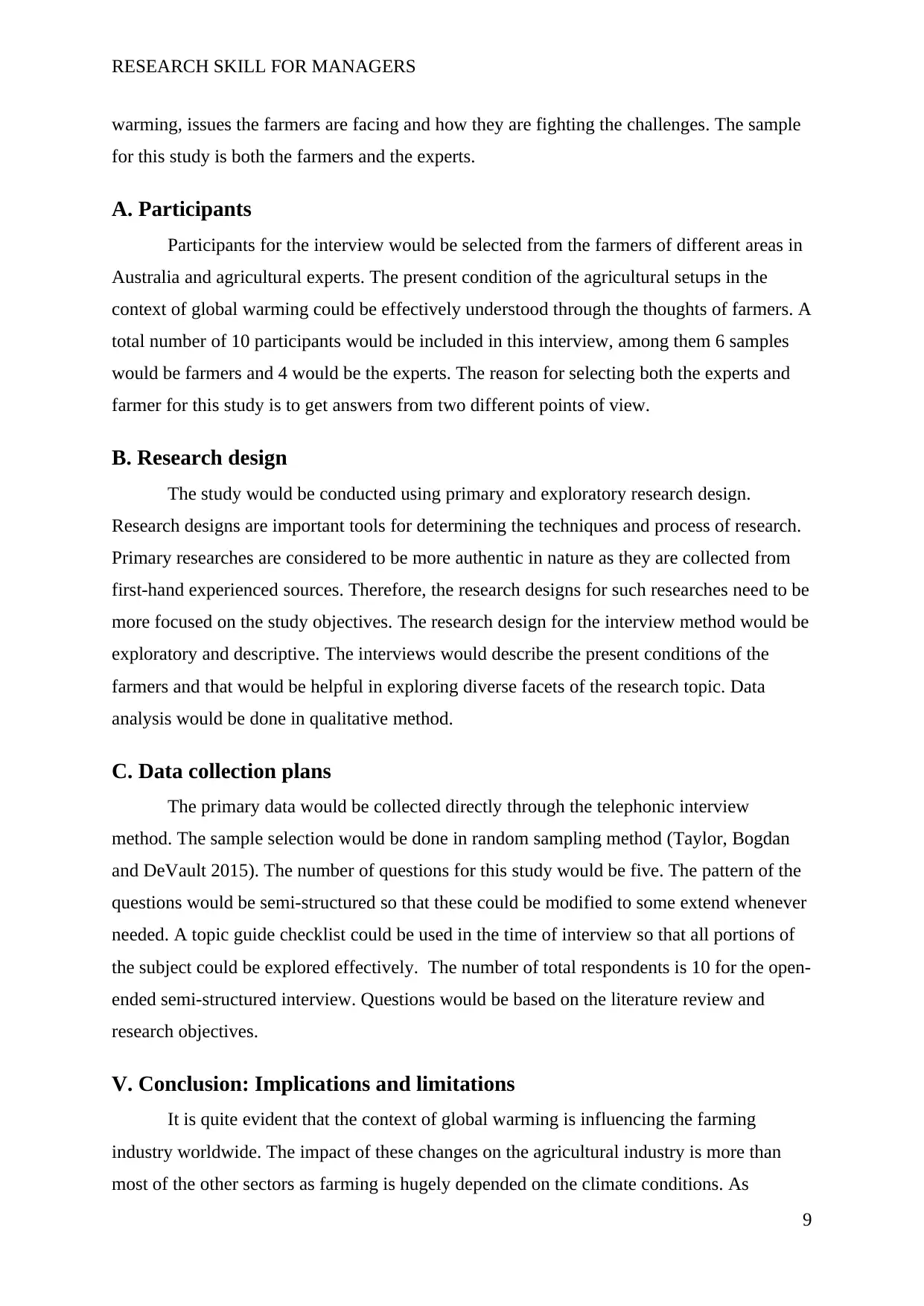
RESEARCH SKILL FOR MANAGERS
warming, issues the farmers are facing and how they are fighting the challenges. The sample
for this study is both the farmers and the experts.
A. Participants
Participants for the interview would be selected from the farmers of different areas in
Australia and agricultural experts. The present condition of the agricultural setups in the
context of global warming could be effectively understood through the thoughts of farmers. A
total number of 10 participants would be included in this interview, among them 6 samples
would be farmers and 4 would be the experts. The reason for selecting both the experts and
farmer for this study is to get answers from two different points of view.
B. Research design
The study would be conducted using primary and exploratory research design.
Research designs are important tools for determining the techniques and process of research.
Primary researches are considered to be more authentic in nature as they are collected from
first-hand experienced sources. Therefore, the research designs for such researches need to be
more focused on the study objectives. The research design for the interview method would be
exploratory and descriptive. The interviews would describe the present conditions of the
farmers and that would be helpful in exploring diverse facets of the research topic. Data
analysis would be done in qualitative method.
C. Data collection plans
The primary data would be collected directly through the telephonic interview
method. The sample selection would be done in random sampling method (Taylor, Bogdan
and DeVault 2015). The number of questions for this study would be five. The pattern of the
questions would be semi-structured so that these could be modified to some extend whenever
needed. A topic guide checklist could be used in the time of interview so that all portions of
the subject could be explored effectively. The number of total respondents is 10 for the open-
ended semi-structured interview. Questions would be based on the literature review and
research objectives.
V. Conclusion: Implications and limitations
It is quite evident that the context of global warming is influencing the farming
industry worldwide. The impact of these changes on the agricultural industry is more than
most of the other sectors as farming is hugely depended on the climate conditions. As
9
warming, issues the farmers are facing and how they are fighting the challenges. The sample
for this study is both the farmers and the experts.
A. Participants
Participants for the interview would be selected from the farmers of different areas in
Australia and agricultural experts. The present condition of the agricultural setups in the
context of global warming could be effectively understood through the thoughts of farmers. A
total number of 10 participants would be included in this interview, among them 6 samples
would be farmers and 4 would be the experts. The reason for selecting both the experts and
farmer for this study is to get answers from two different points of view.
B. Research design
The study would be conducted using primary and exploratory research design.
Research designs are important tools for determining the techniques and process of research.
Primary researches are considered to be more authentic in nature as they are collected from
first-hand experienced sources. Therefore, the research designs for such researches need to be
more focused on the study objectives. The research design for the interview method would be
exploratory and descriptive. The interviews would describe the present conditions of the
farmers and that would be helpful in exploring diverse facets of the research topic. Data
analysis would be done in qualitative method.
C. Data collection plans
The primary data would be collected directly through the telephonic interview
method. The sample selection would be done in random sampling method (Taylor, Bogdan
and DeVault 2015). The number of questions for this study would be five. The pattern of the
questions would be semi-structured so that these could be modified to some extend whenever
needed. A topic guide checklist could be used in the time of interview so that all portions of
the subject could be explored effectively. The number of total respondents is 10 for the open-
ended semi-structured interview. Questions would be based on the literature review and
research objectives.
V. Conclusion: Implications and limitations
It is quite evident that the context of global warming is influencing the farming
industry worldwide. The impact of these changes on the agricultural industry is more than
most of the other sectors as farming is hugely depended on the climate conditions. As
9
Paraphrase This Document
Need a fresh take? Get an instant paraphrase of this document with our AI Paraphraser
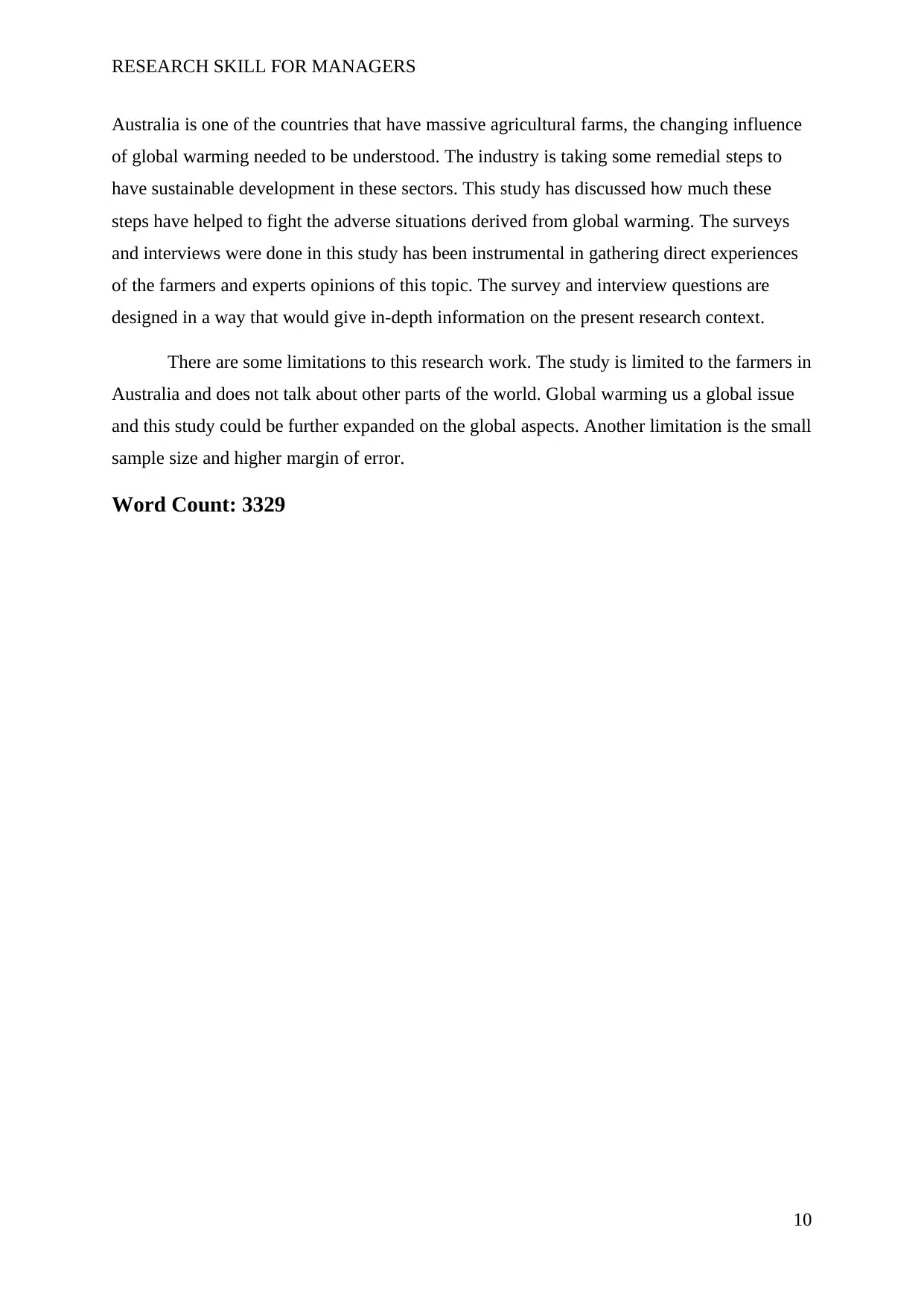
RESEARCH SKILL FOR MANAGERS
Australia is one of the countries that have massive agricultural farms, the changing influence
of global warming needed to be understood. The industry is taking some remedial steps to
have sustainable development in these sectors. This study has discussed how much these
steps have helped to fight the adverse situations derived from global warming. The surveys
and interviews were done in this study has been instrumental in gathering direct experiences
of the farmers and experts opinions of this topic. The survey and interview questions are
designed in a way that would give in-depth information on the present research context.
There are some limitations to this research work. The study is limited to the farmers in
Australia and does not talk about other parts of the world. Global warming us a global issue
and this study could be further expanded on the global aspects. Another limitation is the small
sample size and higher margin of error.
Word Count: 3329
10
Australia is one of the countries that have massive agricultural farms, the changing influence
of global warming needed to be understood. The industry is taking some remedial steps to
have sustainable development in these sectors. This study has discussed how much these
steps have helped to fight the adverse situations derived from global warming. The surveys
and interviews were done in this study has been instrumental in gathering direct experiences
of the farmers and experts opinions of this topic. The survey and interview questions are
designed in a way that would give in-depth information on the present research context.
There are some limitations to this research work. The study is limited to the farmers in
Australia and does not talk about other parts of the world. Global warming us a global issue
and this study could be further expanded on the global aspects. Another limitation is the small
sample size and higher margin of error.
Word Count: 3329
10
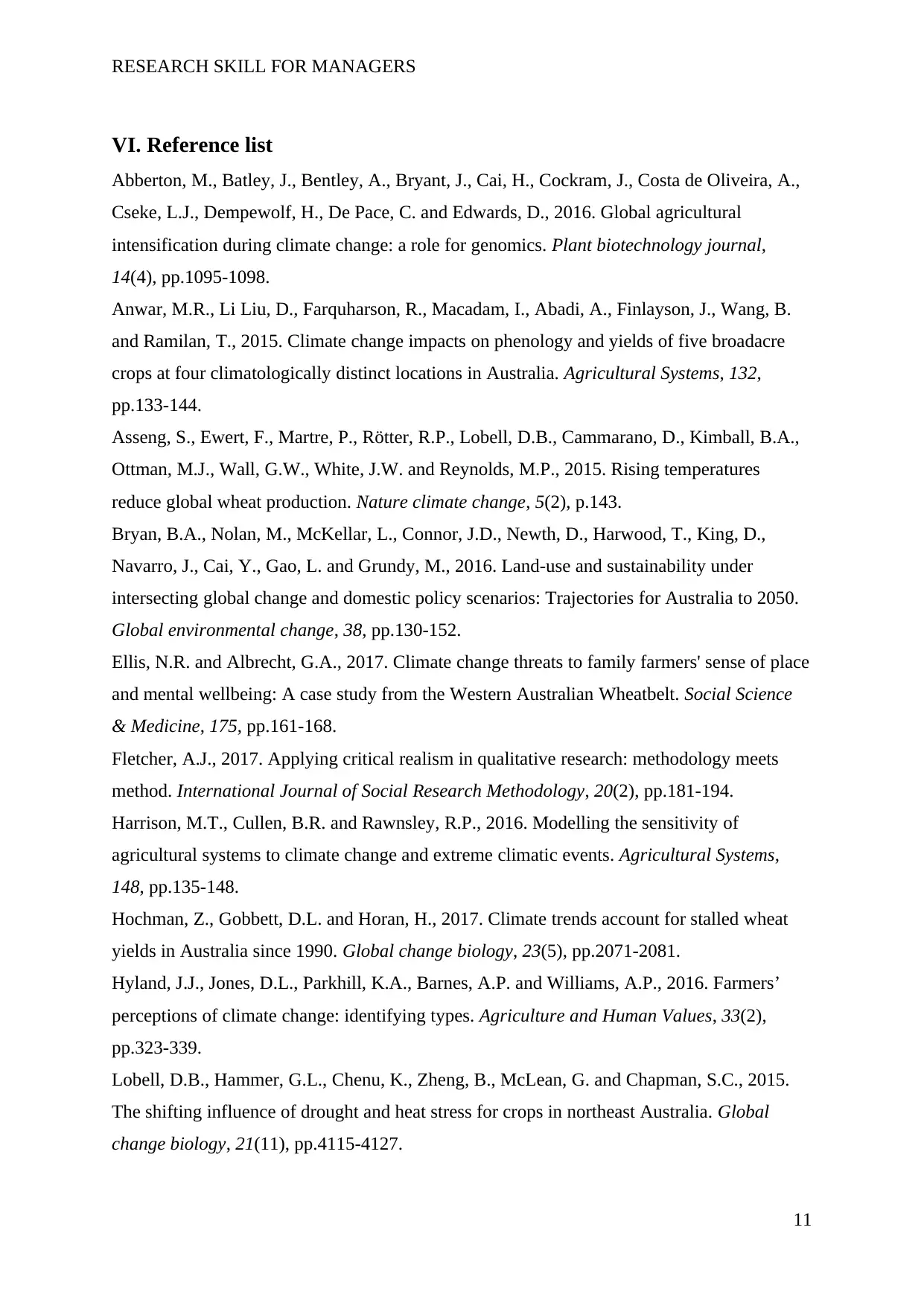
RESEARCH SKILL FOR MANAGERS
VI. Reference list
Abberton, M., Batley, J., Bentley, A., Bryant, J., Cai, H., Cockram, J., Costa de Oliveira, A.,
Cseke, L.J., Dempewolf, H., De Pace, C. and Edwards, D., 2016. Global agricultural
intensification during climate change: a role for genomics. Plant biotechnology journal,
14(4), pp.1095-1098.
Anwar, M.R., Li Liu, D., Farquharson, R., Macadam, I., Abadi, A., Finlayson, J., Wang, B.
and Ramilan, T., 2015. Climate change impacts on phenology and yields of five broadacre
crops at four climatologically distinct locations in Australia. Agricultural Systems, 132,
pp.133-144.
Asseng, S., Ewert, F., Martre, P., Rötter, R.P., Lobell, D.B., Cammarano, D., Kimball, B.A.,
Ottman, M.J., Wall, G.W., White, J.W. and Reynolds, M.P., 2015. Rising temperatures
reduce global wheat production. Nature climate change, 5(2), p.143.
Bryan, B.A., Nolan, M., McKellar, L., Connor, J.D., Newth, D., Harwood, T., King, D.,
Navarro, J., Cai, Y., Gao, L. and Grundy, M., 2016. Land-use and sustainability under
intersecting global change and domestic policy scenarios: Trajectories for Australia to 2050.
Global environmental change, 38, pp.130-152.
Ellis, N.R. and Albrecht, G.A., 2017. Climate change threats to family farmers' sense of place
and mental wellbeing: A case study from the Western Australian Wheatbelt. Social Science
& Medicine, 175, pp.161-168.
Fletcher, A.J., 2017. Applying critical realism in qualitative research: methodology meets
method. International Journal of Social Research Methodology, 20(2), pp.181-194.
Harrison, M.T., Cullen, B.R. and Rawnsley, R.P., 2016. Modelling the sensitivity of
agricultural systems to climate change and extreme climatic events. Agricultural Systems,
148, pp.135-148.
Hochman, Z., Gobbett, D.L. and Horan, H., 2017. Climate trends account for stalled wheat
yields in Australia since 1990. Global change biology, 23(5), pp.2071-2081.
Hyland, J.J., Jones, D.L., Parkhill, K.A., Barnes, A.P. and Williams, A.P., 2016. Farmers’
perceptions of climate change: identifying types. Agriculture and Human Values, 33(2),
pp.323-339.
Lobell, D.B., Hammer, G.L., Chenu, K., Zheng, B., McLean, G. and Chapman, S.C., 2015.
The shifting influence of drought and heat stress for crops in northeast Australia. Global
change biology, 21(11), pp.4115-4127.
11
VI. Reference list
Abberton, M., Batley, J., Bentley, A., Bryant, J., Cai, H., Cockram, J., Costa de Oliveira, A.,
Cseke, L.J., Dempewolf, H., De Pace, C. and Edwards, D., 2016. Global agricultural
intensification during climate change: a role for genomics. Plant biotechnology journal,
14(4), pp.1095-1098.
Anwar, M.R., Li Liu, D., Farquharson, R., Macadam, I., Abadi, A., Finlayson, J., Wang, B.
and Ramilan, T., 2015. Climate change impacts on phenology and yields of five broadacre
crops at four climatologically distinct locations in Australia. Agricultural Systems, 132,
pp.133-144.
Asseng, S., Ewert, F., Martre, P., Rötter, R.P., Lobell, D.B., Cammarano, D., Kimball, B.A.,
Ottman, M.J., Wall, G.W., White, J.W. and Reynolds, M.P., 2015. Rising temperatures
reduce global wheat production. Nature climate change, 5(2), p.143.
Bryan, B.A., Nolan, M., McKellar, L., Connor, J.D., Newth, D., Harwood, T., King, D.,
Navarro, J., Cai, Y., Gao, L. and Grundy, M., 2016. Land-use and sustainability under
intersecting global change and domestic policy scenarios: Trajectories for Australia to 2050.
Global environmental change, 38, pp.130-152.
Ellis, N.R. and Albrecht, G.A., 2017. Climate change threats to family farmers' sense of place
and mental wellbeing: A case study from the Western Australian Wheatbelt. Social Science
& Medicine, 175, pp.161-168.
Fletcher, A.J., 2017. Applying critical realism in qualitative research: methodology meets
method. International Journal of Social Research Methodology, 20(2), pp.181-194.
Harrison, M.T., Cullen, B.R. and Rawnsley, R.P., 2016. Modelling the sensitivity of
agricultural systems to climate change and extreme climatic events. Agricultural Systems,
148, pp.135-148.
Hochman, Z., Gobbett, D.L. and Horan, H., 2017. Climate trends account for stalled wheat
yields in Australia since 1990. Global change biology, 23(5), pp.2071-2081.
Hyland, J.J., Jones, D.L., Parkhill, K.A., Barnes, A.P. and Williams, A.P., 2016. Farmers’
perceptions of climate change: identifying types. Agriculture and Human Values, 33(2),
pp.323-339.
Lobell, D.B., Hammer, G.L., Chenu, K., Zheng, B., McLean, G. and Chapman, S.C., 2015.
The shifting influence of drought and heat stress for crops in northeast Australia. Global
change biology, 21(11), pp.4115-4127.
11
⊘ This is a preview!⊘
Do you want full access?
Subscribe today to unlock all pages.

Trusted by 1+ million students worldwide
1 out of 17
Related Documents
Your All-in-One AI-Powered Toolkit for Academic Success.
+13062052269
info@desklib.com
Available 24*7 on WhatsApp / Email
![[object Object]](/_next/static/media/star-bottom.7253800d.svg)
Unlock your academic potential
Copyright © 2020–2025 A2Z Services. All Rights Reserved. Developed and managed by ZUCOL.





